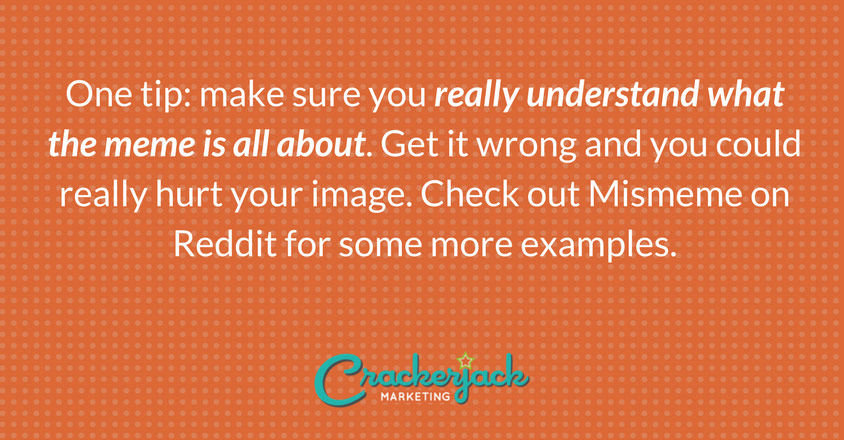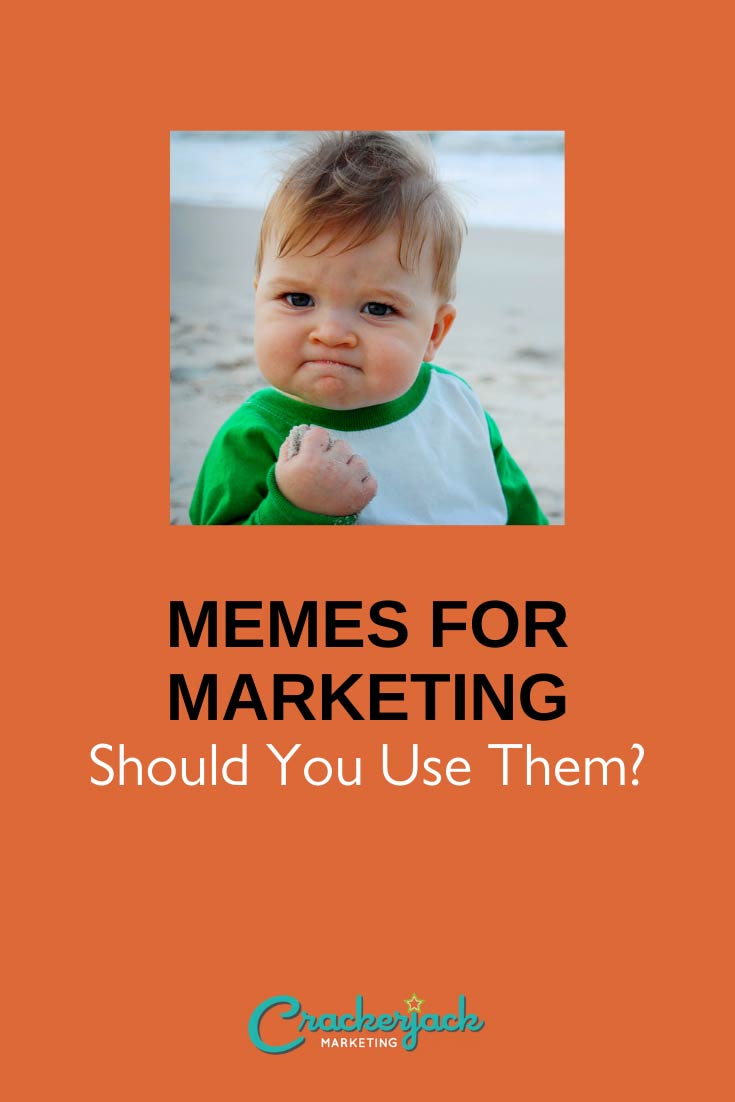Memes for Marketing: Should You Use Them?

Is it possible to go a whole day online without seeing a meme? Wherever you look on social media, you find those amusing combinations of images and text sending a short, sharp message. Marketers can use memes in marketing, too.
Originally a meme was simply “an idea, behavior, style, or usage that spreads from person to person within a culture” (Merriam-Webster) but now it can be a piece of content – usually visual – that spreads quickly and may even go viral. A case in point: all the memes around Donald Trump, many of which focus on his hair and fake tan.
Getting Started with Memes
Using memes in your marketing can show that you’re in touch with what your customers are talking about. They can also give your brand some personality. For example, Grammarly has built an audience of more than 7 million by using images with grammar on Facebook and other social media channels. Several of these tap into popular memes.
Hubspot believes that memejacking is a great strategy for brands. That means hijacking a meme that you already know is popular and putting your own spin on it. That allows you to ride the trend while gaining more attention.
One tip: make sure you really understand what the meme is all about. Get it wrong and you could really hurt your image. Check out Mismeme on Reddit for some more examples.

Seven Tips on Using Memes for Marketing
So, how do you use memes effectively in your marketing strategy? Here are some tips:
- Check to see what’s already popular. There are several great sources of meme intel including Know Your Meme and Memebase. Use those to see whether your planned meme is hot – or not!
- Keep an eye on your social media streams. If you’re repeatedly seeing versions of the same image , that’s sure sign that a meme is on the rise.
- Check out trending topics on your favorite social media site and see if there are any particular images that go along with them.
- Keep tabs on current events that lend themselves to humor.
- Decide on the idea and brainstorm some possible takes on it.
- Use an online meme generator (try this Google search) to help you create it.
- Be selective! Be sure that the meme is aligned with your brand. And, remember, in this case too much of a good thing is a bad thing. Too many memes can have a negative impact on your brand in social.
Tips for Meme Success
When creating memes, be careful about the copyright of the original images. If it’s not clear who owns them, you’d be better off creating your own. In fact, the Success Kid meme started when a photographer uploaded an image of her 11 month old son in 2007. People are still using this image for new memes today.
The final element you need for meme success is social sharing. Share your meme everywhere: on the main social media profiles and within groups. Don’t be afraid to share a meme more than once. The only exception is LinkedIn, where people generally expect more serious, business-related content. Other than that, use your normal content marketing workflow to help your memes to achieve their potential.
Used well, memes can be a useful part of your content marketing strategy so don’t be afraid to try them out.

She’s been in social media for over 20 years, and teaches digital marketing at universities in Barcelona and Bangkok.
Follow her on LinkedIn
for expert LinkedIn and marketing advice.
STEPHANIE SCHWAB
CEO & Founder
Stephanie is the Founder and CEO of Crackerjack Marketing.
She’s been in social media for over 20 years, and teaches digital marketing at universities in Barcelona and Bangkok.
Follow her on LinkedIn
for expert LinkedIn and marketing advice.
Categories
Memes for Marketing: Should You Use Them?

Is it possible to go a whole day online without seeing a meme? Wherever you look on social media, you find those amusing combinations of images and text sending a short, sharp message. Marketers can use memes in marketing, too.
Originally a meme was simply “an idea, behavior, style, or usage that spreads from person to person within a culture” (Merriam-Webster) but now it can be a piece of content – usually visual – that spreads quickly and may even go viral. A case in point: all the memes around Donald Trump, many of which focus on his hair and fake tan.
Getting Started with Memes
Using memes in your marketing can show that you’re in touch with what your customers are talking about. They can also give your brand some personality. For example, Grammarly has built an audience of more than 7 million by using images with grammar on Facebook and other social media channels. Several of these tap into popular memes.
Hubspot believes that memejacking is a great strategy for brands. That means hijacking a meme that you already know is popular and putting your own spin on it. That allows you to ride the trend while gaining more attention.
One tip: make sure you really understand what the meme is all about. Get it wrong and you could really hurt your image. Check out Mismeme on Reddit for some more examples.

Seven Tips on Using Memes for Marketing
So, how do you use memes effectively in your marketing strategy? Here are some tips:
- Check to see what’s already popular. There are several great sources of meme intel including Know Your Meme and Memebase. Use those to see whether your planned meme is hot – or not!
- Keep an eye on your social media streams. If you’re repeatedly seeing versions of the same image , that’s sure sign that a meme is on the rise.
- Check out trending topics on your favorite social media site and see if there are any particular images that go along with them.
- Keep tabs on current events that lend themselves to humor.
- Decide on the idea and brainstorm some possible takes on it.
- Use an online meme generator (try this Google search) to help you create it.
- Be selective! Be sure that the meme is aligned with your brand. And, remember, in this case too much of a good thing is a bad thing. Too many memes can have a negative impact on your brand in social.
Tips for Meme Success
When creating memes, be careful about the copyright of the original images. If it’s not clear who owns them, you’d be better off creating your own. In fact, the Success Kid meme started when a photographer uploaded an image of her 11 month old son in 2007. People are still using this image for new memes today.
The final element you need for meme success is social sharing. Share your meme everywhere: on the main social media profiles and within groups. Don’t be afraid to share a meme more than once. The only exception is LinkedIn, where people generally expect more serious, business-related content. Other than that, use your normal content marketing workflow to help your memes to achieve their potential.
Used well, memes can be a useful part of your content marketing strategy so don’t be afraid to try them out.

Search our Blog
Get our Free Editorial Calendar Template.
Are you stressed out by the time it takes to create great content?
In this handy Google Doc, which you can save and use on your own, you’ll get a super-simple layout to guide your content creation and management efforts.
DOWNLOAD TODAY
STEPHANIE SCHWAB
CEO & Founder
Stephanie founder and CEO of Crackerjack Marketing.
She’s been in social media for over 20 years, and teaches digital marketing at universities in Barcelona and Bangkok.
Follow her on LinkedIn
for expert LinkedIn and marketing advice.
Create your own spark
Join 5,000+ marketers who receive our B2B marketing ideas and insights each week.
Join 5,000+ marketers who receive our B2B marketing ideas and insights each week.
Who We Serve
Company
Who We Are
Our Services
Blog
Free Editorial Calendar Template
Work With Us
Resources
Chicago, Barcelona, Mumbai
1055 W. Bryn Mawr Suite F-196
Chicago, IL 60660
+1-312-429-5588
Headquarters:
© Copyright 2025 Kyle Partners, LLC, d/b/a Crackerjack Marketing. All rights reserved. | Terms of Service | Privacy Policy
